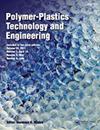Preparation and Assessment of Phase Morphology, Rheological Properties, and Thermal Behavior of Low-Density Polyethylene/Polyhexene-1 Blends
Q2 Materials Science
引用次数: 11
Abstract
ABSTRACT In this work, polyhexene-1 (PH-1) is synthesized by polymerization of hexane-1 with Ziegler–Natta catalyst and melt blended with low-density polyethylene (LDPE). The phase morphology, rheology, crystallization, and thermal behavior of (LDPE)/PH-1 blends are investigated. A good compatibility is observed in the blends up to 10 wt% PH-1 and the most of the droplets in the fractured surface are covered with and buried in the LDPE matrix and at higher percentage the droplet particle size significantly increased. The effect of microstructure of the blends on the flow behavior is studied by small amplitude oscillation rheology. By decreasing the compatibility and increasing the particle size, the Cole–Cole plots are deviated from the semi-circular shape at higher percentages than 10 wt% of PH-1. The change in the crystallization and melting behavior of LDPE in the blends are studied by differential scanning calorimetry and X-ray diffraction (XRD). It is found that by increasing the PH-1 the melting temperature of LDPE decreased from 112.5 to 110.8°C and crystallization temperature increased from 95.2 to 97.7°C which is evident of the nucleation effect. The intensity of (110) peak in XRD test declined as a remake of amorphous part of LDPE and the degree of crystallinity of LDPE decreased from 28 to 22% at 20 wt% PH-1. GRAPHICAL ABSTRACT低密度聚乙烯/聚己烯-1共混物的制备及相形态、流变性能和热行为的评价
摘要本研究采用Ziegler-Natta催化剂将己烷-1与低密度聚乙烯(LDPE)熔体共混聚合,合成了聚己烯-1 (PH-1)。研究了(LDPE)/PH-1共混物的相形态、流变学、结晶和热行为。在高达10 wt% PH-1的共混物中观察到良好的相容性,并且裂缝表面的大多数液滴被LDPE基体覆盖并埋在基体中,当液滴百分比较高时,液滴粒径显着增加。采用小振幅振荡流变学方法研究了共混物微观结构对流动性能的影响。通过降低相容性和增大粒径,Cole-Cole图偏离半圆形状的比例高于PH-1的10 wt%。采用差示扫描量热法和x射线衍射(XRD)研究了共混物中LDPE结晶和熔化行为的变化。结果表明,随着PH-1的增加,LDPE的熔融温度从112.5℃降低到110.8℃,结晶温度从95.2℃提高到97.7℃,这是明显的成核效应。在20 wt% PH-1条件下,LDPE的(110)峰强度下降,结晶度从28%下降到22%。图形抽象
本文章由计算机程序翻译,如有差异,请以英文原文为准。
求助全文
约1分钟内获得全文
求助全文
来源期刊

Polymer-Plastics Technology and Engineering
工程技术-高分子科学
CiteScore
1.71
自引率
0.00%
发文量
0
审稿时长
4 months
 求助内容:
求助内容: 应助结果提醒方式:
应助结果提醒方式:


